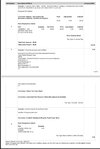I know you NEW Tesla's with the Li-Ion Battery don't have this problem.. But for those with the dinosaur 12v batteries, is there a certain voltage, time, miles you guys replace yours?
I know Tesla is supposed to be good at that and let you know to replace it soon. However, we are going to the Cybertruck event, DRIVING THERE, from CA, and I want Daddy Chill to be in TIP top shape.
I went to the secret service menu and no issues. When the car is on the 12v is running around 13v?
Currently at 3 Years 57k miles
Also, I DID let the HV battery die completely to see how many extra miles I got, VIDEO on that soon, but it was only dead for like 5 min before I plugged in.
TY!
I know Tesla is supposed to be good at that and let you know to replace it soon. However, we are going to the Cybertruck event, DRIVING THERE, from CA, and I want Daddy Chill to be in TIP top shape.
I went to the secret service menu and no issues. When the car is on the 12v is running around 13v?
Currently at 3 Years 57k miles
Also, I DID let the HV battery die completely to see how many extra miles I got, VIDEO on that soon, but it was only dead for like 5 min before I plugged in.
TY!



